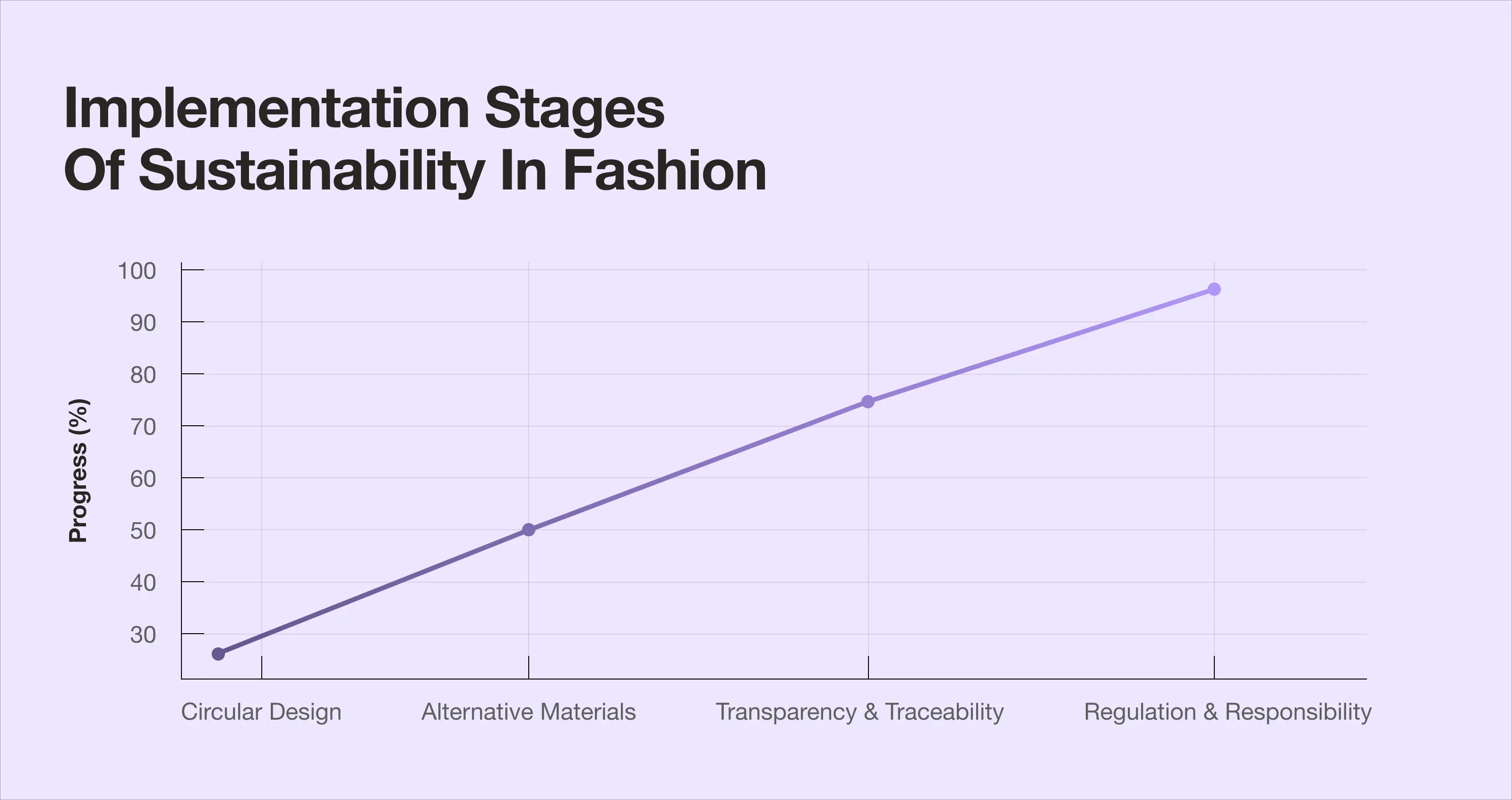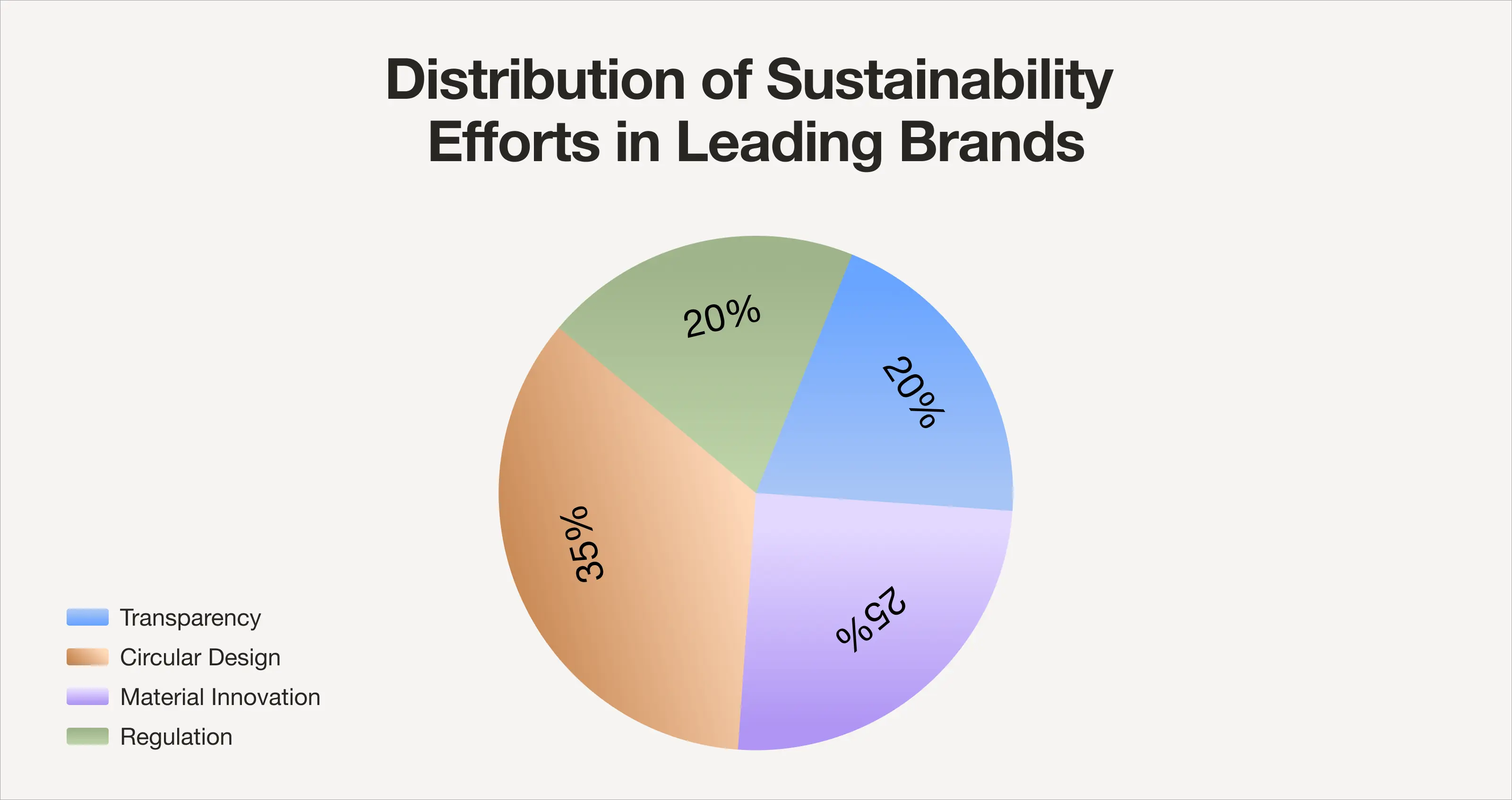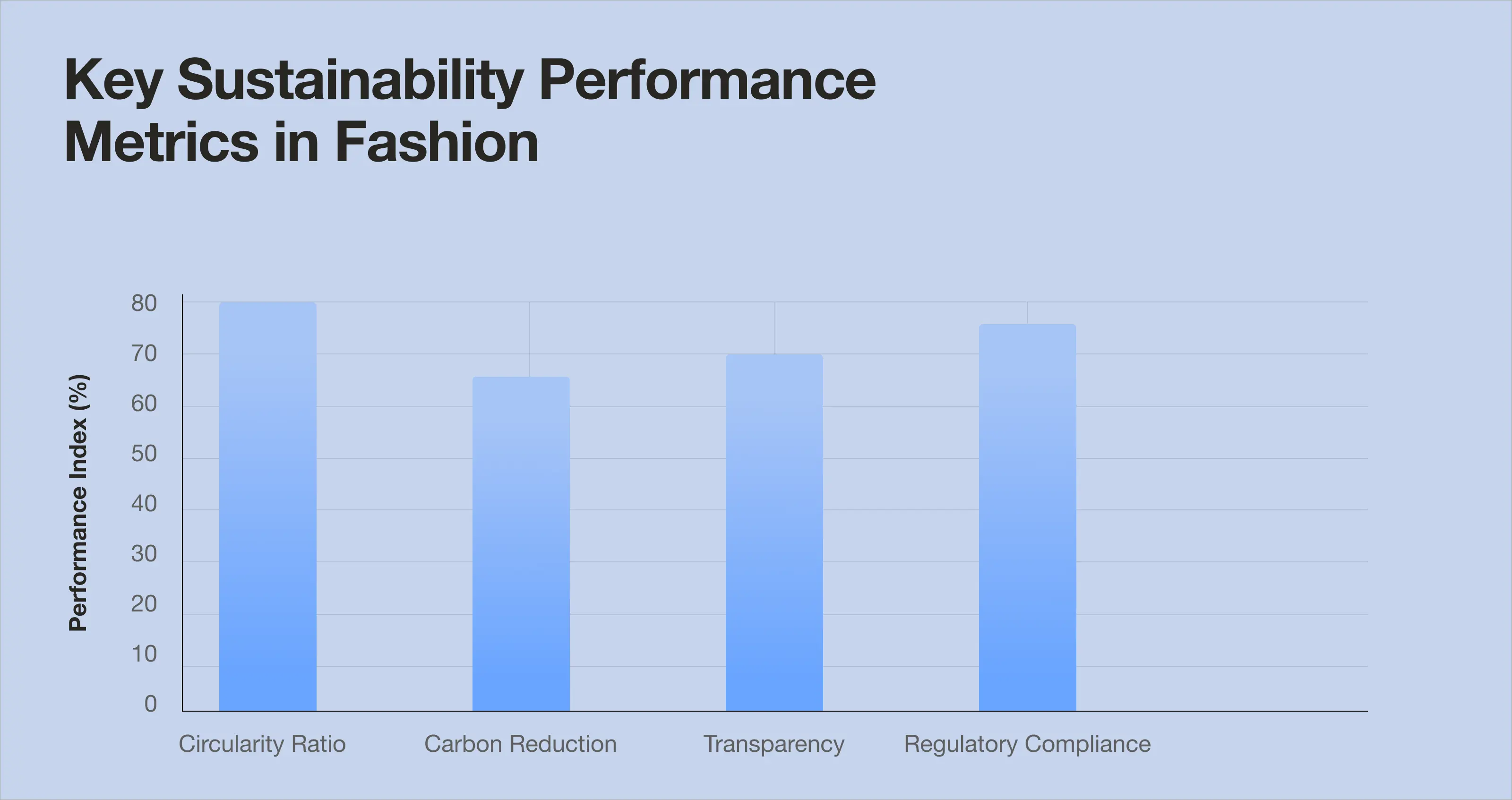Sustainability in fashion operations: For innovative leaders

The conversation around ethics and sustainability in fashion has moved beyond optics. For executives, it’s no longer enough to “have a sustainable line” or issue broad corporate statements. The pressures from consumers, regulators and investors are structural, systemic, and immediate. Leading brands are not only adopting ethical practices—they are embedding them into business strategy, operations, and decision-making.
This post breaks down the four pillars executives need to understand deeply, with concrete actions to implement ethics and sustainability in fashion across product development, supply chain management and corporate governance.
Sustainability in fashion: circular design and waste reduction strategies
Circular design is one of the most powerful levers for driving sustainability in fashion. It’s not a buzzword or a seasonal campaign—it’s a fundamental shift in how products are conceived, produced, and managed throughout their lifecycle. While most leaders are familiar with the concept, many underestimate the operational changes required to make circularity both scalable and profitable.
Here’s how to build circular practices into your core business, reduce waste, and extend product life cycles in ways that deliver measurable impact.
1. Design for longevity
Durability must become a core business metric, not a marketing tagline. Products built to last reduce waste, enhance brand reputation, and increase customer lifetime value. Direct your design and sourcing teams to evaluate:
- Fabric performance
Strength, abrasion resistance, and pilling resistance that extend garment lifespan. - Repairability
Modular construction and replaceable components that make repair possible. - Timeless design
Aesthetic longevity that keeps garments relevant beyond a single season.
Build a product durability index into your development process and track it alongside traditional KPIs. Brands like Accio have linked durability scores to go-to-market decisions, cutting return rates and reducing end-of-season waste.
2. Turn deadstock into a strategic asset
Deadstock isn’t just a loss—it’s an untapped opportunity. Sustainability in fashion increasingly depends on how brands manage surplus materials and unsold inventory. Go beyond markdowns or donations by:
- Upcycling
Transforming excess stock into new collections or capsule lines. - Collaborations
Partnering with smaller designers or sustainability-focused labels to reimagine leftover materials. - Innovation
Developing internal R&D programs that convert deadstock into secondary product categories.
Create a cross-functional deadstock task force (merchandising, design, and sustainability) that meets quarterly to identify high-value reuse opportunities and integrate them into product roadmaps.
3. Build circularity into your supply chain
Sustainability in fashion doesn’t stop at the product—it must be embedded in operations, logistics, and end-of-life strategies. Consider how your supply chain can enable circularity by:
- Take-back programs
Creating structured paths for garment recycling, resale, or refurbishment. - Supplier alignment
Auditing partners for recyclability, repairability, and sustainable packaging standards. - Lifecycle tracking
Using digital tools to monitor materials from sourcing through post-consumer return.

Deploy a digital lifecycle management system that integrates with your existing operations. This will help track material flows, flag inefficiencies, and surface data to guide executive decisions on circular KPIs.
Plant-based & alternative materials: Integrating innovation into sustainability in fashion strategies
Material innovation is one of the most powerful levers for advancing sustainability in fashion. The conversation is shifting from creating token “eco-friendly” capsule collections to embedding alternative materials into the core of product development and brand strategy. For fashion executives, this is about driving environmental impact and long-term brand credibility.
1. Evaluate alternative materials based on full lifecycle impact
Plant-based leathers made from mushroom mycelium or pineapple fiber, as well as regenerative natural fibers like organic cotton and hemp, vary significantly in carbon footprint, water consumption, and chemical use. Simply swapping materials without understanding their full lifecycle impact can undermine sustainability goals.
Conduct a material lifecycle assessment (LCA) for all core fabrics. Use that data to prioritize alternatives that offer measurable reductions in emissions and resource use, without sacrificing quality, scalability, or supply chain resilience.
2. Integrate sustainable materials strategically, not symbolically
Embedding sustainability in fashion requires more than occasional innovation. Executives should guide sourcing and design teams to:
- Replace high-impact materials in high-volume product categories first.
- Combine alternative materials with circular design principles to maximize sustainability gains.
- Standardize sourcing processes to ensure scalability and cost predictability.
Establish small-scale material innovation pilots in critical product categories, track adoption rates, and scale the most successful substitutions across entire collections.
3. Leverage material innovation for consumer trust and engagement
Today’s consumers want proof of sustainability, not just promises. Executives can strengthen brand trust by ensuring material claims are transparent and verifiable:
- Add QR codes or interactive dashboards showing fiber origin and production data.
- Obtain third-party certifications and publish audit results.
- Integrate storytelling about regenerative sourcing and material innovation into marketing and product pages.

A material transparency framework that connects sourcing data with consumer-facing storytelling strengthens both brand credibility and competitive differentiation.
Transparency & traceability: Turning visibility into strategic advantage
True sustainability in fashion extends far beyond raw materials. Supply chain transparency is now a strategic tool for risk management, operational efficiency, and brand differentiation. Forward-thinking executives treat traceability not as a compliance requirement, but as a source of business intelligence and value creation.
1. Map your supply chain end-to-end
Most brands know their Tier 1 suppliers, but the biggest sustainability gains often lie deeper. Full visibility into Tier 2 and Tier 3 suppliers reveals opportunities to improve environmental and social impact:
- Raw material extraction sites.
- Subcontracted manufacturers and logistics partners.
- End-of-life handling, recycling, and resale channels.
Conduct a comprehensive supply chain audit and classify suppliers based on risk and impact to prioritize interventions that strengthen sustainability performance.
2. Implement robust data systems for traceability
Accurate, real-time data is the backbone of sustainable operations. Technologies like blockchain, digital product passports, and lifecycle management platforms enable end-to-end visibility while informing key decisions:
- Identify bottlenecks and waste points.
- Monitor supplier compliance with labor and environmental standards.
- Measure circularity and sustainability KPIs tied to executive dashboards.
Invest in integrated traceability platforms that connect sourcing, production, and retail teams, creating a unified, transparent view of product impact.
3. Use transparency to build trust and market value
Supply chain visibility is not just an internal advantage—it’s a marketable differentiator:
- Highlight verified sourcing and production credentials in marketing.
- Educate consumers on product origin, labor practices, and environmental impact.
- Provide credible proof points for ESG reporting and investor communications.
Launch a consumer-facing transparency initiative with measurable engagement goals, positioning traceability as a core component of brand value.
Legislation & producer responsibility: Turning compliance into opportunity
As regulations around sustainability in fashion tighten globally—particularly in Europe—producers are increasingly accountable for a garment’s entire lifecycle. These shifts are more than legal obligations; they’re strategic opportunities for forward-thinking brands.
1. Understand evolving regulatory landscapes
Key areas of legislation include:
- Textile waste reduction mandates.
- Restrictions on incineration or destruction of unsold stock.
- Producer responsibility requirements for recycling and take-back programs.
Maintain a regulatory monitoring system across all regions to anticipate changes and respond proactively rather than reactively.
2. Embed compliance into operational strategy
Sustainability and ethics must shape decisions at every level:
- Forecast demand more accurately to prevent overproduction.
- Develop pricing strategies aligned with end-of-life recycling obligations.
- Include environmental performance requirements in supplier contracts.
Integrate regulatory KPIs into supply chain operations and executive performance dashboards, turning compliance into a measurable driver of sustainability outcomes.
3. Use regulation as a catalyst for innovation
Regulatory pressure can accelerate transformation and innovation:
- Early adoption of circular models positions brands as industry leaders.
- Compliance programs often unlock operational efficiencies and reduce costs.
- Demonstrating leadership on sustainability builds trust with consumers, investors, and partners.
Develop a regulatory innovation roadmap linking compliance requirements to product development and business opportunities.
Building a practical sustainability roadmap
To embed sustainability in fashion into the core of your business, executives need a structured roadmap with clear goals, accountability, and operational integration.
1. Set measurable sustainability targets
KPIs should include:
- Material circularity ratios.
- Carbon and water footprint reductions.
- Supply chain transparency coverage.
- Compliance rates with regulatory requirements.

2. Align incentives and governance structures
Tie sustainability performance to executive dashboards, performance reviews, and incentive systems. Ensure design, sourcing, merchandising, and marketing teams share accountability for progress.
3. Pilot, measure, and scale innovations
Start with focused pilot projects in key product categories or supply chain segments. Measure outcomes rigorously, scale successful initiatives, and refine continuously as technologies, materials, and policies evolve.
4. Communicate internally and externally
Authentic, impact-driven storytelling builds trust and engagement among employees, consumers, and investors. Focus on tangible results—material innovation, waste reduction, traceability, and ethical practices—rather than vague sustainability claims.
Turning sustainability in fashion into a competitive advantage
Sustainability in fashion is no longer optional—it’s a core strategic pillar. For industry leaders, it’s a driver of revenue, operational efficiency, risk mitigation and brand differentiation.
The most successful brands will integrate circular design, alternative materials, supply chain traceability, and regulatory readiness into their core operations thus linking measurable sustainability outcomes to business growth.
<blogcta>
Executives who act decisively now will define the future of fashion, building resilient, credible, and profitable brands that meet the evolving expectations of consumers, regulators and investors alike.
.webp)


.webp)
